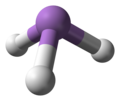
Back Arsien Afrikaans أرسين Arabic آرسین AZB Arsà Catalan Arsan Czech Arsin Danish Arsenwasserstoff German Αρσίνη Greek Arsano Spanish آرسین Persian

| |||
| |||
| Names | |||
|---|---|---|---|
| IUPAC names
Arsenic trihydride
Arsane Trihydridoarsenic | |||
| Other names
Arseniuretted hydrogen,
Arsenous hydride, Hydrogen arsenide Arsenic hydride | |||
| Identifiers | |||
3D model (JSmol)
|
|||
| ChEBI | |||
| ChEMBL | |||
| ChemSpider | |||
| ECHA InfoCard | 100.029.151 | ||
| EC Number |
| ||
| 599 | |||
| KEGG | |||
PubChem CID
|
|||
| RTECS number |
| ||
| UNII | |||
| UN number | 2188 | ||
CompTox Dashboard (EPA)
|
|||
| |||
| |||
| Properties | |||
| AsH3 | |||
| Molar mass | 77.9454 g/mol | ||
| Appearance | Colourless gas | ||
| Odor | Faint, garlic-like | ||
| Density | 4.93 g/L, gas; 1.640 g/mL (−64 °C) | ||
| Melting point | −111.2 °C (−168.2 °F; 162.0 K) | ||
| Boiling point | −62.5 °C (−80.5 °F; 210.7 K) | ||
| 0.2 g/100 mL (20 °C)[1] 0.07 g/100 mL (25 °C) | |||
| Solubility | soluble in chloroform, benzene | ||
| Vapor pressure | 14.9 atm[1] | ||
| Conjugate acid | Arsonium | ||
| Structure | |||
| Trigonal pyramidal | |||
| 0.20 D | |||
| Thermochemistry | |||
Std molar
entropy (S⦵298) |
223 J⋅K−1⋅mol−1 | ||
Std enthalpy of
formation (ΔfH⦵298) |
+66.4 kJ/mol | ||
| Hazards | |||
| Occupational safety and health (OHS/OSH): | |||
Main hazards
|
Extremely toxic, explosive, flammable, potential occupational carcinogen[1] | ||
| GHS labelling: | |||
   
| |||
| Danger | |||
| H220, H330, H373, H410 | |||
| P210, P260, P271, P273, P284, P304+P340, P310, P314, P320, P377, P381, P391, P403, P403+P233, P405, P501 | |||
| NFPA 704 (fire diamond) | |||
| Flash point | −62 °C (−80 °F; 211 K) | ||
| Explosive limits | 5.1–78%[1] | ||
| Lethal dose or concentration (LD, LC): | |||
LD50 (median dose)
|
2.5 mg/kg (intravenous)[2] | ||
LC50 (median concentration)
|
| ||
LCLo (lowest published)
|
| ||
| NIOSH (US health exposure limits): | |||
PEL (Permissible)
|
TWA 0.05 ppm (0.2 mg/m3)[1] | ||
REL (Recommended)
|
C 0.002 mg/m3 [15-minute][1] | ||
IDLH (Immediate danger)
|
3 ppm[1] | ||
| Related compounds | |||
Related hydrides
|
Ammonia; phosphine; stibine; bismuthine | ||
| Supplementary data page | |||
| Arsine (data page) | |||
Except where otherwise noted, data are given for materials in their standard state (at 25 °C [77 °F], 100 kPa).
| |||
Arsine (IUPAC name: arsane) is an inorganic compound with the formula AsH3. This flammable, pyrophoric, and highly toxic pnictogen hydride gas is one of the simplest compounds of arsenic.[4] Despite its lethality, it finds some applications in the semiconductor industry and for the synthesis of organoarsenic compounds. The term arsine is commonly used to describe a class of organoarsenic compounds of the formula AsH3−xRx, where R = aryl or alkyl. For example, As(C6H5)3, called triphenylarsine, is referred to as "an arsine".
- ^ a b c d e f g NIOSH Pocket Guide to Chemical Hazards. "#0040". National Institute for Occupational Safety and Health (NIOSH).
- ^ Levvy, G.A. (1946). "The Toxicity of Arsine Administered by Intraperitoneal Injection". British Journal of Pharmacology and Chemotherapy. 1 (4): 287–290. doi:10.1111/j.1476-5381.1946.tb00049.x. PMC 1509744. PMID 19108099.
- ^ a b Cite error: The named reference
IDLHwas invoked but never defined (see the help page). - ^ Cite error: The named reference
Hollemanwas invoked but never defined (see the help page).
© MMXXIII Rich X Search. We shall prevail. All rights reserved. Rich X Search


